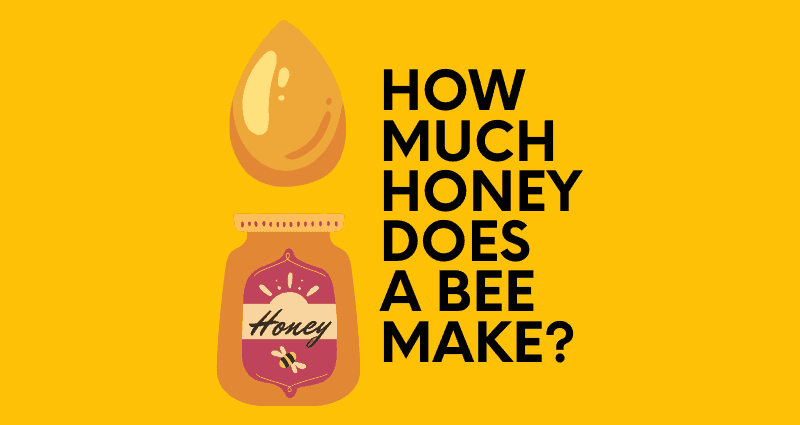Honey bees are remarkable. They spend all of their time gathering nectar to produce honey which sustains them over the colder winter months.
However, all that buzzing begs the question of how much honey does a honey bee make in its lifetime?
How much honey does a single bee produce?
A single honey bee produces only 1/12 of a teaspoon of honey during its life.
Given that the average honey bee lives only six weeks and spends one-half of that time caring for the hive and young, it is remarkable that it can make even 1/12 of a teaspoon of honey.
How much honey does a bee make in a day?
A honey bee lives for just six weeks and spends the first three weeks working inside the hive. The next three weeks are spent collecting and delivering nectar.
Since a single honey bee produces just 1/12 of a teaspoon during its life, and the bee spends just 3 weeks producing honey, we can estimate that a single bee produces less than 4/1000 of a teaspoon of honey per day.
In other words, it takes 252 bees to produce 1 teaspoon of honey each day.
How much honey does a bee make in a year?
A single honey bee lives only six weeks, and in that time, makes 1/12 of a teaspoon of honey.
So if you want to know how much honey bees make year-round, we would look at a year and say 60 honey bee lives make up a year of honey production.
To get an entire year of honey production, you would need the original bee and 59 replacements. It takes 12 bees to make a full teaspoon of honey. So in a year, those 60 honey bees would make five teaspoons of honey.
- One honey bee makes 1 1/2 teaspoon of honey in six weeks.
- Sixty honey bees make five teaspoons of honey in a year.
- Six hundred eighty-three honey bees take a year to make a 9.5-ounce jar of honey.
- A hive of 50,000 honey bees would produce 5.4 gallons of honey in a year.
How much honey does a bee colony produce?
An entire colony of bees can make around 5.4 gallons of honey per year. That's roughly 45 pounds of honey.
FUN FACT: 1 pound of honey weighs an average of 12 pounds. Click here to learn more about the factors that contribute to honey weight.
The actual amount of honey a colony makes depends on how many worker bees are in the hive, how much nectar and pollen are available, how many brood boxes and honey supers are used, the size of the brood boxes and honey supers, and how short the spring and summer seasons are.
An entire beehive flies around 40,000 miles per year, and individual bees fly about six miles per day to collect nectar. Nectar is 70-80 percent water. So to make honey, the water must be removed by evaporation or by the bees. Unfortunately, the process depletes the payload of each bee by up to 80%.
So while honey bees collect a lot of nectar, they only produce about 1/12 of a teaspoon of honey during their six-week lifespan.
How many bees does it take to produce an average jar of honey?
It takes just under 700 bees to produce a 9.5-ounce jar of honey. The actual number is between 670-683 honey bees.
One teaspoon of honey is .17 ounces, and there are 57 teaspoons of honey in a 9.5-ounce jar.
Since it takes 12 bees to produce a single teaspoon of honey, it would take about 670 honey bees to create enough honey to fill a 9.5-ounce jar if nothing goes wrong.
How much honey is produced each year?
From around the world, there are about 1.85 million metric tons of honey produced each year.
That number is staggering and brings to the forefront just how important honey bees are for food production, pollination, and honey production.
How does bee health affect honey production?
A single worker honey bee flies about six miles per day, and healthy bees can do this without a problem. However, honey bee workers only enter the honey production phase in the last half of their life. One reason for the late entry is that their loss is not as detrimental to the hive.
Bees in poor health have a more challenging time foraging and cannot fly as far or as often. Without the constant “grind” to collect nectar and pollen, the amount of honey produced by that bee drops.
Consider that one work honey bee may visit 5,000 flowers in a single day to collect enough nectar to produce a scant amount of honey. Sick will, therefore, visit fewer flowers and bring back less nectar.
Bee health is paramount in maintaining honey production for both the hive and other organisms using honey.
How does hive health affect honey production?
The better the health of the hive, the higher the production of honey is. As with single bees, if the hive is sick or unable to reproduce as fast, the production of honey drops. This is because it takes a lot of work to make honey, and it is difficult to work when you are sick. The same is true of bees.
What’s more, is that not every worker bee that leaves the hive returns.
When a hive cannot replace lost workers, fewer bees bring in nectar, tend to the young, and create honey. In those hives, the population of bees declines, and honey production drops.
For these reasons, queen bees have the very important job of replenishing the bee population at a constant rate and the worker bees remain protective of the queen bee.
Click here to learn more about Brood Boxes. The area of the hive where the queen bee lays eggs and grows the hive population.
Common Issues That Affect Hive Health
There are many reasons why hive health may suffer. Here are a few possibilities.
- Parasites
- Viruses
- Bacterial Diseases
- Pesticides
- Nutrition
- Genetics
- Queen Quality
- Predators
- Hive Structure
Ways To Increase Honey Production
There are several ways beekeepers can ensure the quality and quantity of honey production increases and remains high. Here are a few to consider;
- Pick the right hive home – proper conditions help ensure bees remain productive. Plenty of flowering plants, water, plant resin, etc.. will allow them to produce honey, survive, and secure their hive with propolis.
- Use frames with drawn comb – frames with already drawn comb helps to save them time and food resources.
- Treat for pests, parasites & diseases – constantly inspect for early signs and take proactive measures to remove them.
- Leave enough reserve honey – having honey reserves available during lackluster production or bad weather will ensure your hives remain strong all year round.
- Feed the bees – pollen and sugar syrup are fantastic foods that bees eat. It helps the bees draw more honeycomb and increase the number of the brood.
- Keep predators out – predators can eat and destroy comb, damage hives, and even kill entire colonies. They may even be human predators. Take precautions and consider cameras when necessary.
- Plant bee-friendly flowers – give your bees the food sources they need to optimize production. Focus on flowering plants that have wide flowers and short proboscis.
Concluding Thoughts
The sheer number of bees needed to produce honey is evidence of how important bees are to our environment but let’s not forget the second and third-order effects that bees have on the ecosystem.
They support the growth of trees, flowers, and other plants. All of which are needed for a healthy and vibrant ecosystem. Protect the bees and we all benefit. Not just from their delicious honey.
To learn how bees make honey, click here to read our full article.

